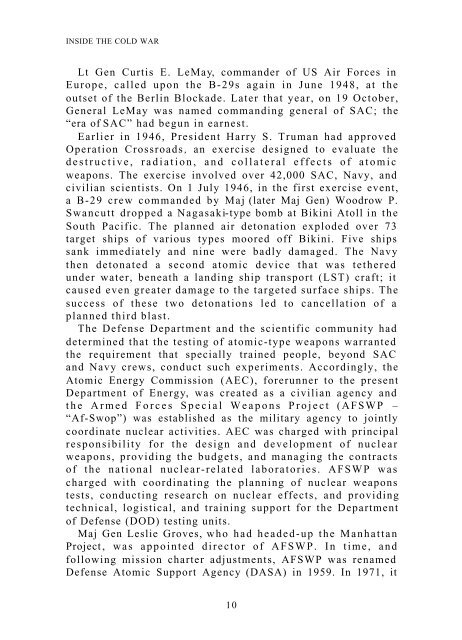You also want an ePaper? Increase the reach of your titles
YUMPU automatically turns print PDFs into web optimized ePapers that Google loves.
INSIDE THE COLD WAR<br />
Lt Gen Curtis E. LeMay, commander of US Air Forces in<br />
Europe, called upon <strong>the</strong> B-29s again in June 1948, at <strong>the</strong><br />
outset of <strong>the</strong> Berlin Blockade. Later that year, on 19 October,<br />
General LeMay was named commanding general of SAC; <strong>the</strong><br />
“era of SAC” had begun in earnest.<br />
Earlier in 1946, President Harry S. Truman had approved<br />
Operation Crossroads, an exercise designed to evaluate <strong>the</strong><br />
destructive, radiation, and collateral effects of atomic<br />
weapons. The exercise involved over 42,000 SAC, Navy, and<br />
civilian scientists. On 1 July 1946, in <strong>the</strong> first exercise event,<br />
a B-29 crew commanded by Maj (later Maj Gen) Woodrow P.<br />
Swancutt dropped a Nagasaki-type bomb at Bikini Atoll in <strong>the</strong><br />
South Pacific. The planned air detonation exploded over 73<br />
target ships of various types moored off Bikini. Five ships<br />
sank immediately and nine were badly damaged. The Navy<br />
<strong>the</strong>n detonated a second atomic device that was te<strong>the</strong>red<br />
under water, beneath a landing ship transport (LST) craft; it<br />
caused even greater damage to <strong>the</strong> targeted surface ships. The<br />
success of <strong>the</strong>se two detonations led to cancellation of a<br />
planned third blast.<br />
The Defense Department and <strong>the</strong> scientific community had<br />
determined that <strong>the</strong> testing of atomic-type weapons warranted<br />
<strong>the</strong> requirement that specially trained people, beyond SAC<br />
and Navy crews, conduct such experiments. Accordingly, <strong>the</strong><br />
Atomic Energy Commission (AEC), forerunner to <strong>the</strong> present<br />
Department of Energy, was created as a civilian agency and<br />
<strong>the</strong> Armed Forces Special Weapons Project (AFSWP –<br />
“Af-Swop”) was established as <strong>the</strong> military agency to jointly<br />
coordinate nuclear activities. AEC was charged with principal<br />
responsibility for <strong>the</strong> design and development of nuclear<br />
weapons, providing <strong>the</strong> budgets, and managing <strong>the</strong> contracts<br />
of <strong>the</strong> national nuclear-related laboratories. AFSWP was<br />
charged with coordinating <strong>the</strong> planning of nuclear weapons<br />
tests, conducting research on nuclear effects, and providing<br />
technical, logistical, and training support for <strong>the</strong> Department<br />
of Defense (DOD) testing units.<br />
Maj Gen Leslie Groves, who had headed-up <strong>the</strong> Manhattan<br />
Project, was appointed director of AFSWP. In time, and<br />
following mission charter adjustments, AFSWP was renamed<br />
Defense Atomic Support Agency (DASA) in 1959. In 1971, it<br />
10
















